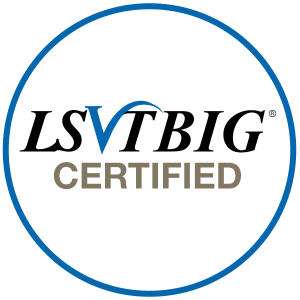
Interventional
Pain Management
Physical Therapy: LSVT BIG® Therapy

JLSVT BIG ® treatment is used to train people with Parkinson’s disease (PD) and certain other neurological conditions to use their body more normally. This therapy can lead to improved fine or gross motor movements such as buttoning clothing or maintaining balance while walking. It can lead to improved mobility, self-care, and other day-to-day tasks by helping those who suffer from PD or other such neurological disorders “recalibrate” their movements. It is customized to help each patient’s specific needs and can help regardless of the stage or severity of they patient’s condition. Our physical therapists and PTAs are all certified in providing LSVT BIG ® treatment.
Global Postural Reeducation (GPR)
GPR is a specific physiotherapeutic approach that involves the reproduction of various common positions (including sitting, standing, laying down, etc.) and obtaining a better understanding of body mechanics. It is designed to use muscle chains to investigate the cause of the patient’s physical ailment. GPR aims to lead to long-term learning to prevent relapses, as well as integrate new movements.
GPR can lead to improvements in respiratory muscle strength, chest expansion, pain, urinary incontinence, TMJ disorders, and postural stability. It can be used in patients suffering from muscle stiffness, muscular retractions, pain related to posture, and general or chronic pain. Benefits of GPR include improvement in pain symptoms, improved flexibility and mobility, improved posture, improved body awareness, and recurrence prevention due to long-term learning.

Our Practices Interventional Pain Management News

Voted Best of the Best 2021 by Victoria Advocate
Two years in a row, our Physical Therapy Department at Victoria Pain and Rehabilitation Center has been voted Best of the Best in the Victoria Advocate by our patients and community.

Tailored Physical Therapy for Parkinson's Disease
We pride ourselves on offering amazing long-term support and helping patients and their families navigate life with Parkinson’s disease.

Voted Best of the Best 2020 by Victoria Advocate
In 2020, the Physical Therapy Department was voted Best of the Best by the Victoria Advocate!

Helping You Manage Joint Pain With Physical Therapy
Whether your joint pain is due to arthritis or an acute condition such as tendinitis, you could benefit from physical therapy.

Dealing With Back Pain Even After Back Surgery?
Dr. Wilson Almonte and Dr. Ted Lin provide other solutions to help get your back pain under control, even after failed back surgery.

Discover Ways Our Pain Specialist Can Help Alleviate Your Hip Pain
Dr. Wilson Almonte and Dr. Ted Lin, can step in and provide you with a wide range of non-surgical solutions to manage your pain without resorting to surgery.

Kyphoplasty For Vertebral Compression Fractures
Vertebral compression fractures most often occur in those with osteoporosis. However, car accidents and sports injuries can also leave you with these spinal fractures. As a result, you may be dealing with chronic back pain or you may even hunch over.

Finding Treatment For A Herniated Disc & Types of Treatment
Your vertebrae are cushioned by round discs with a protective outer layer. A herniated disc occurs when a fragment of the disc nucleus is pushed out of that outer layer, into the spine.

Learn What causes sacroiliac joint dysfunction
Dysfunction or inflammation of the sacroiliac joint, or SI joint, can often lead to pelvic or lower back pain. Since so many conditions and injuries can also lead to pain in the pelvis or lower back, it can be a bit difficult to pinpoint when the SI joint could be the cause.

Dealing with Degenerative Disc Disease?
This condition occurs over the years, as a result of constant motion and stress on the spine. This normal wear and tear can lead to deterioration of the discs of the spine, particularly the neck and lower back. This is something that can and often does get worse as we get older.